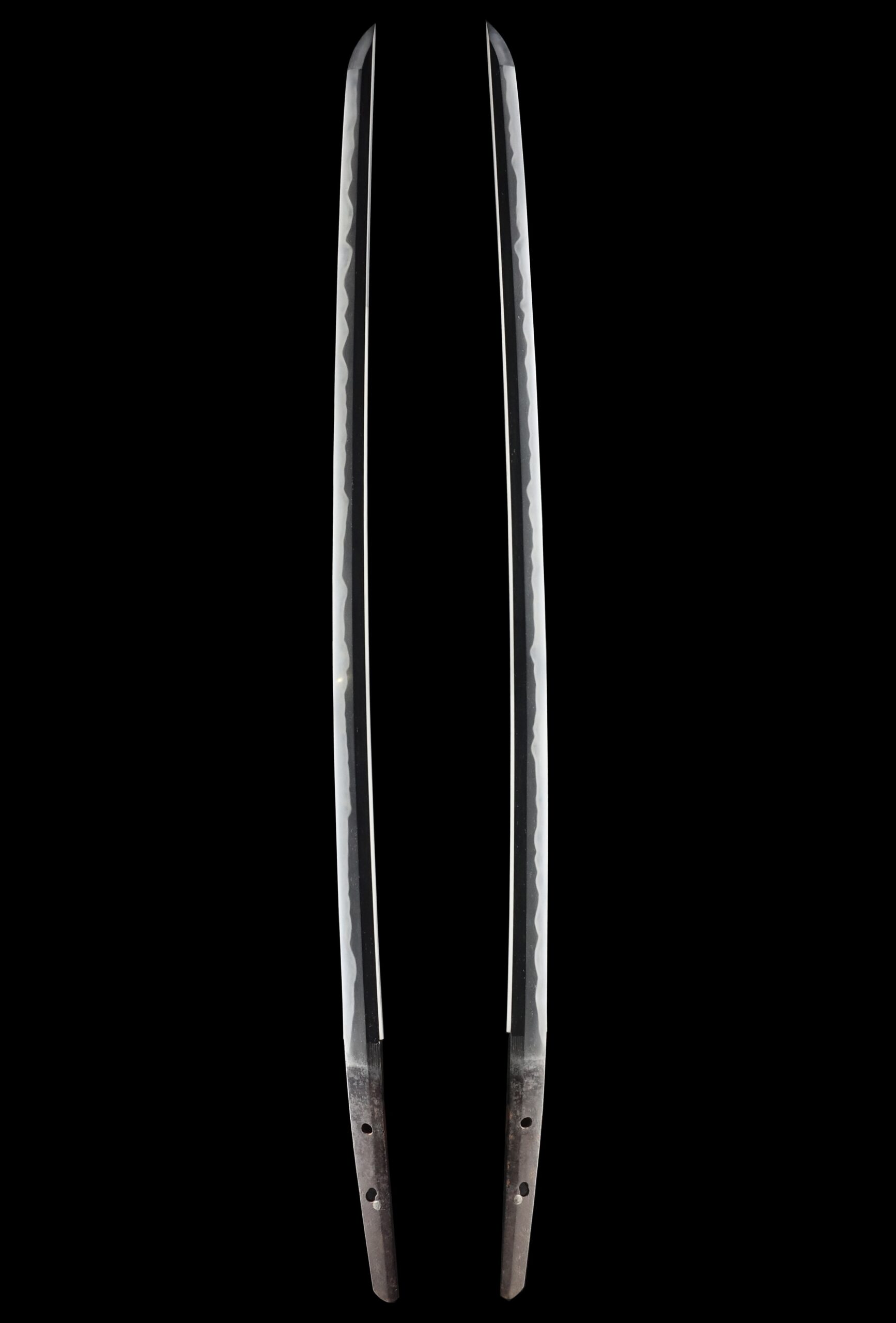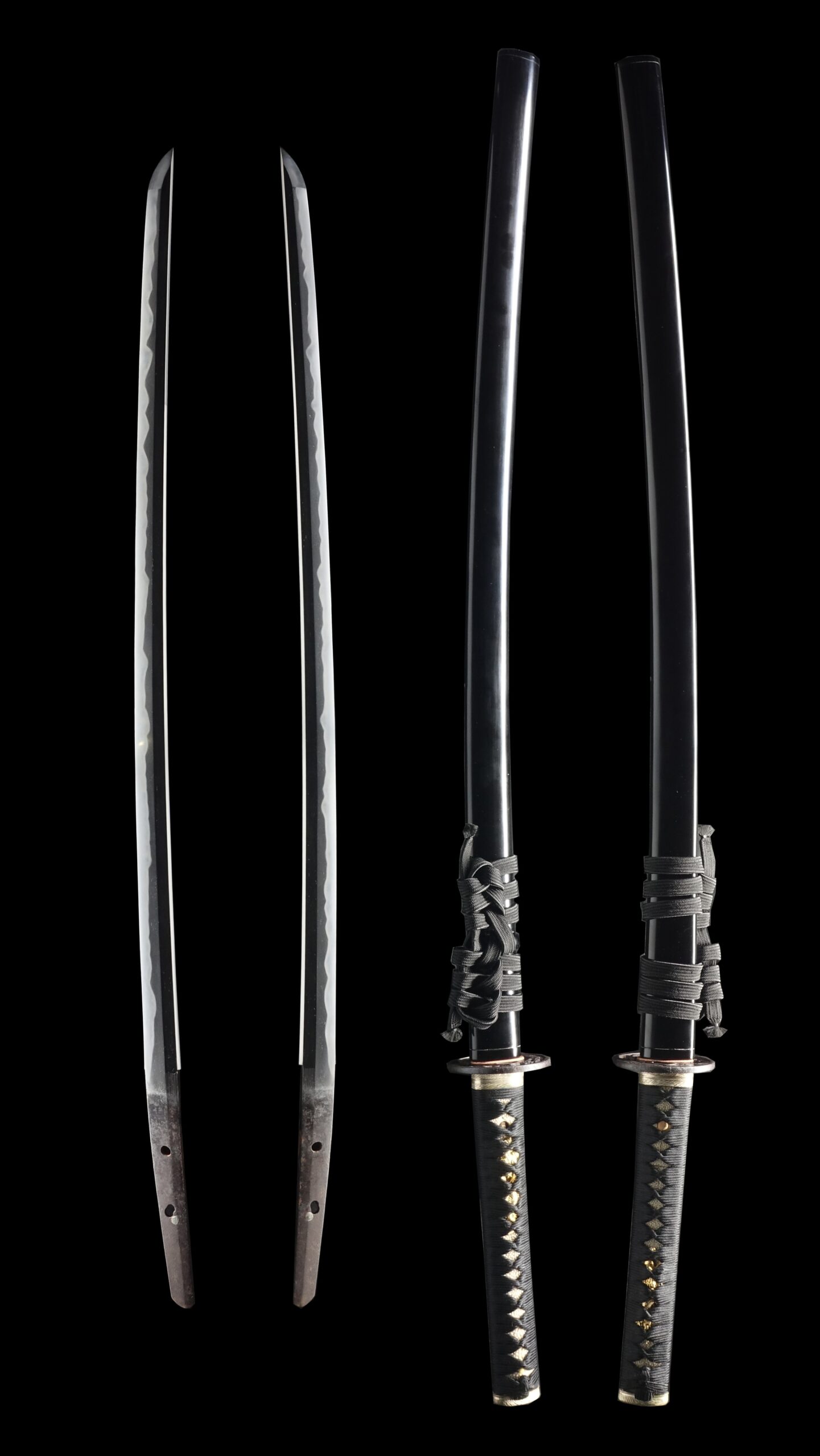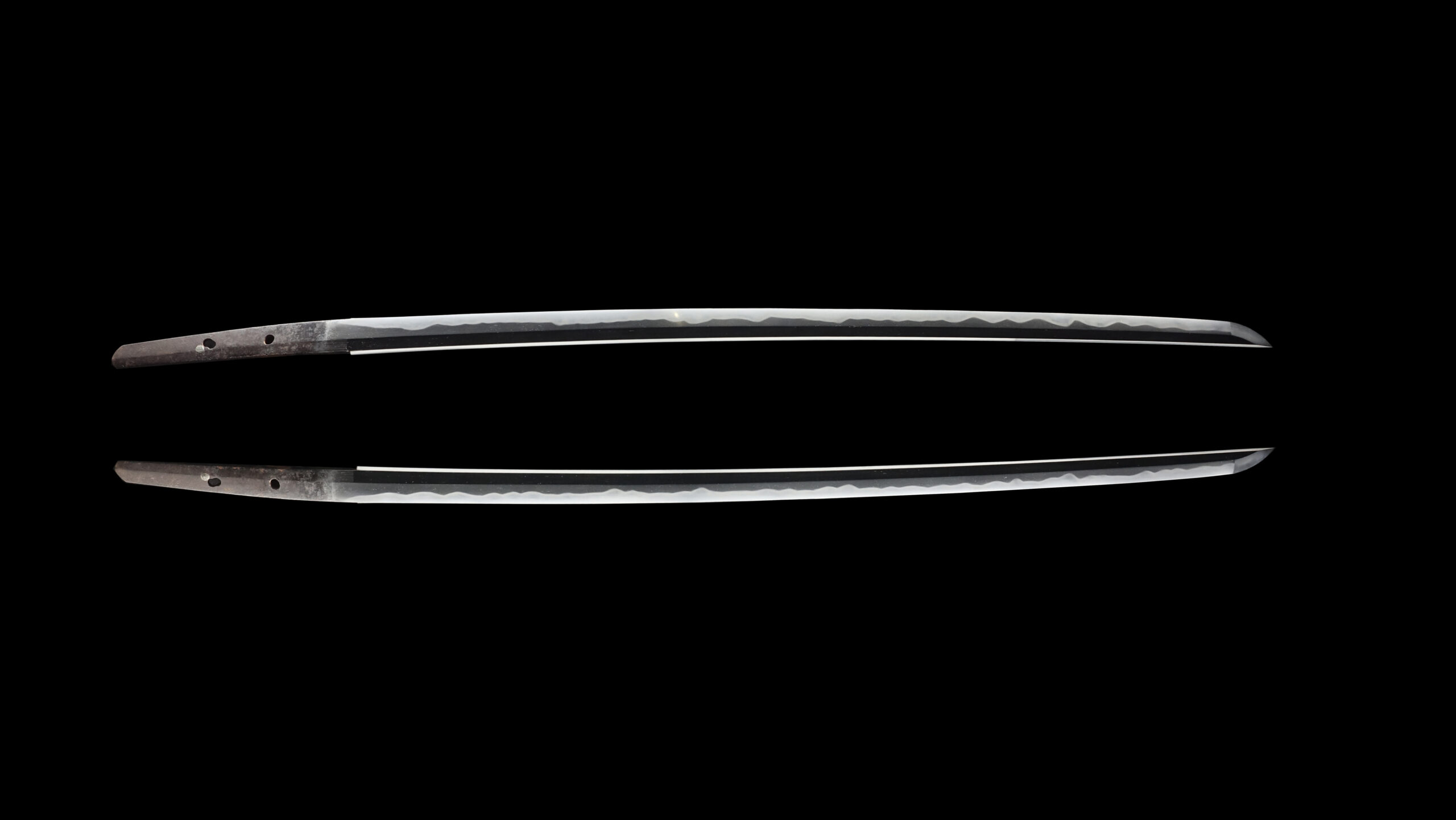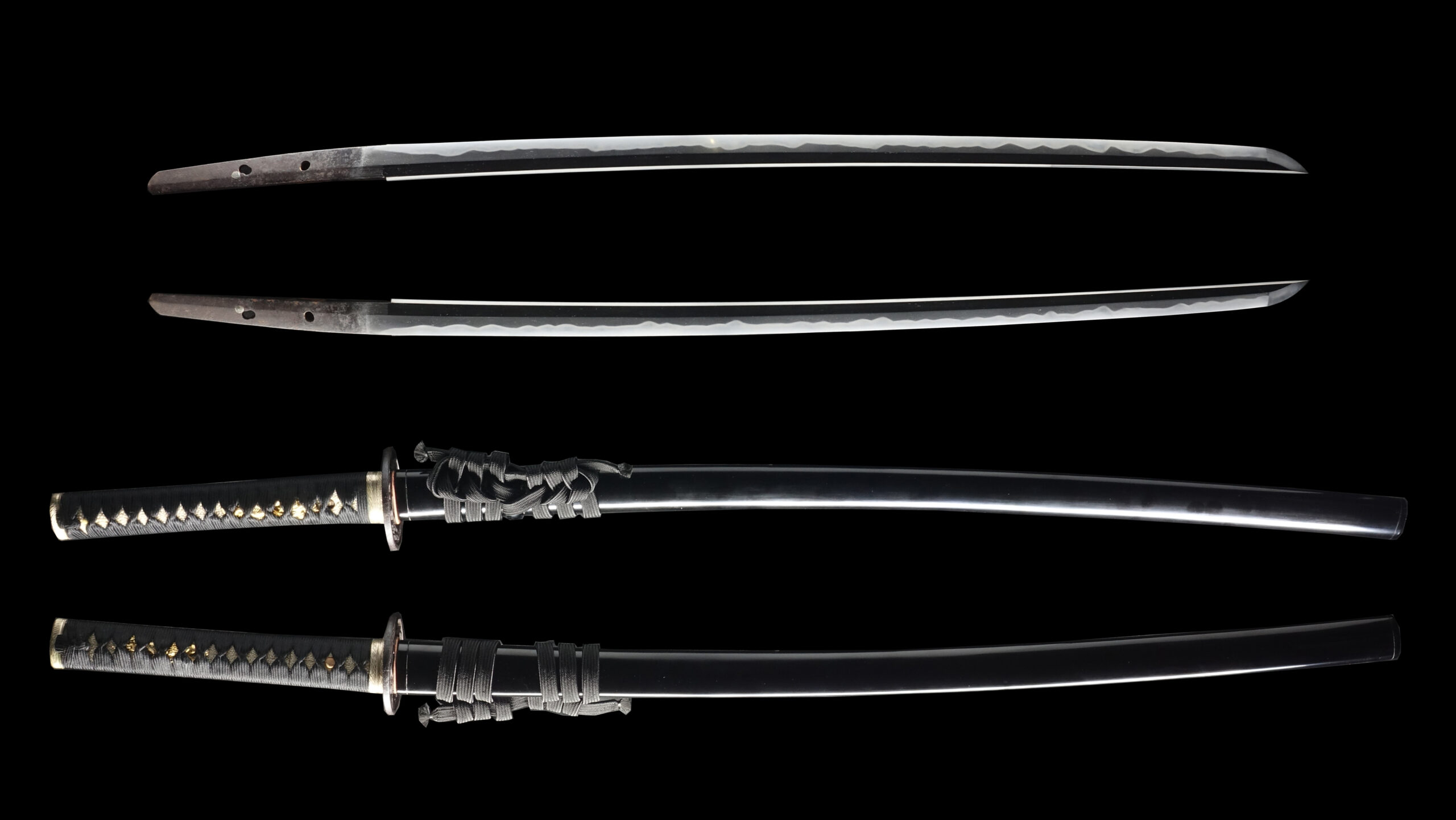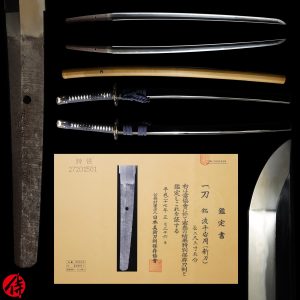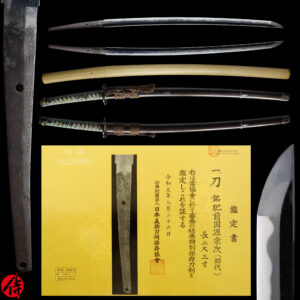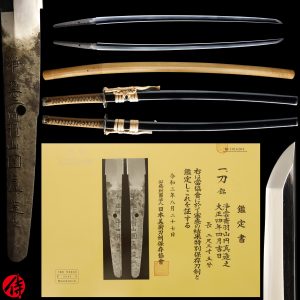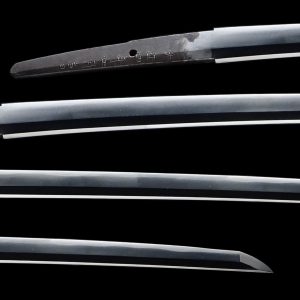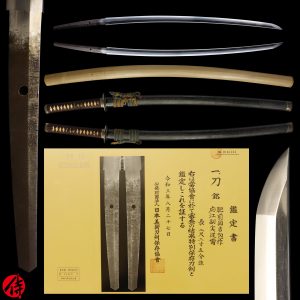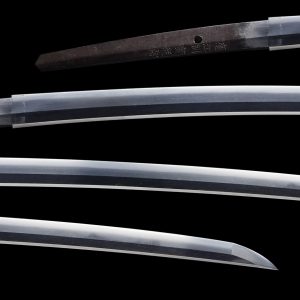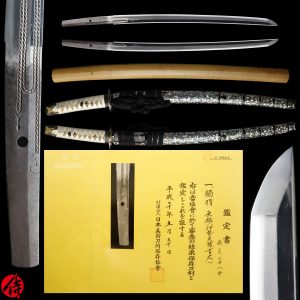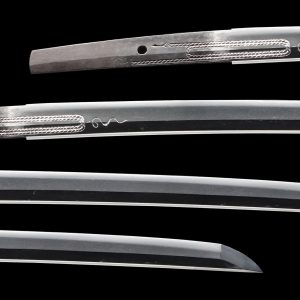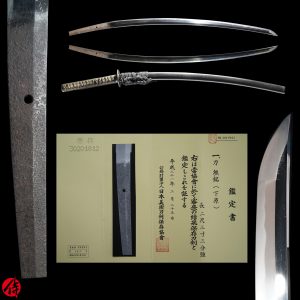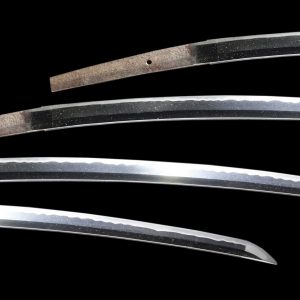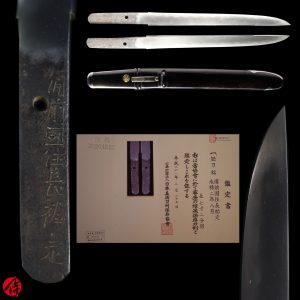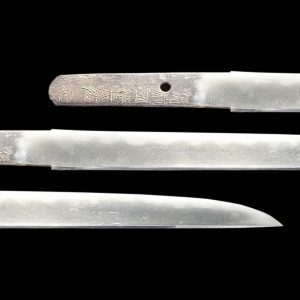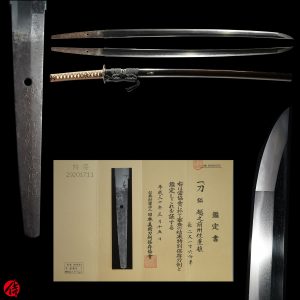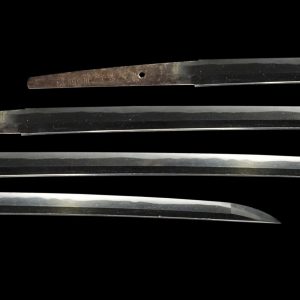Antique Japanese Sword Katana Attributed to the third-gen Munetsugu with NTHK Kanteisho Certificate
【Description】
Summary
This blade is attributed to the third-gen Iyojo Munetsugu (三代伊代掾宗次), who was active during the Tenwa era (1681-1684: Early Edo Period), according to its NTHK’s appraisal. The maker’s name Munetsugu lasted eight generations, and they all resided in Hizen province (Today’s Saga prefecture). The first-gen Munetsugu was one of the most famous swordsmiths during the early Edo period in Hizen province. And the third-gen Munetsugu was known for forging powerful swords. It is said that some of the blades he created were used for test cutting of a Samurai helmet, and because of the sharpness and toughness of his swords, the helmets were cut in half. The third-gen Munetsugu served Isahaya clan, an influential clan in the Hizen province.
The first-gen Munetsugu
The first-gen Munetsugu was born in a household that served the Tenmangu shrine as priests for generations in Nagase village in Hizen province. His birth name was Sakai Sanuemon. And he first signed Masatsugu. He took over his father’s school in the 12th year of the Tensho era (1584).
In the 11th year of the Keicho era (1606), he received Iyo Jyo title for his excellent craftsmanship. Additionally, in the 16th year of the Keicho era (1611), he was hired to forge blades for Nameshima Katsushige, the first head of Nameshima clan, who ruled Hizen province. And he became a Hanko (藩工), a swordsmith exclusively working for a specific clan or domain. He passed his name to the second-gen Munetsugu in the 9th year of the Kan-Ei era (1632). Considering his title isn’t engraved on this blade, we assume it was made before 1606.
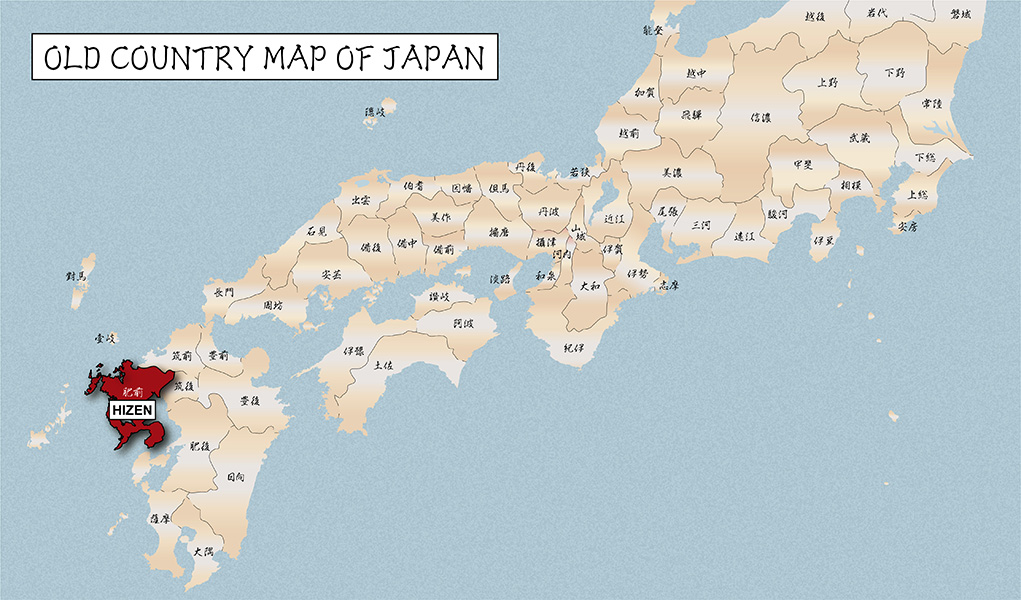
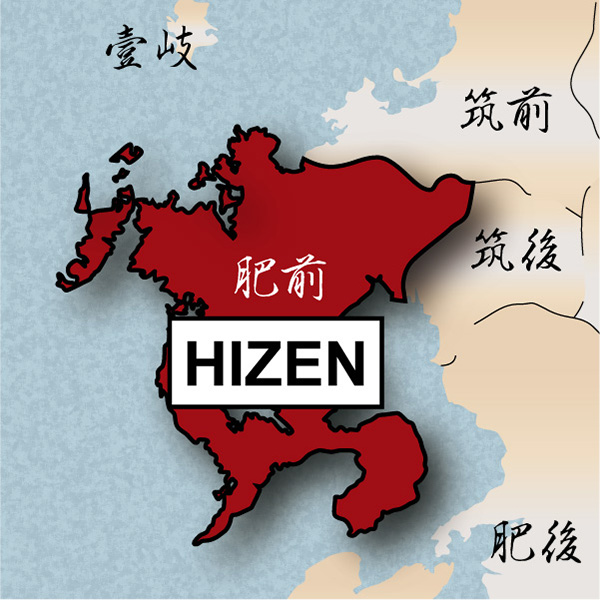
One of the most famous episodes related to the first-gen Munetsugu is that he forged a blade to commemorate the visit of the Shogun Tokugawa Iemitsu to Kyoto in July, the 11th year of the Kan-Ei era (1634). This fact indicates that the first-gen Munetsugu was a highly regarded swordsmith nationwide back then.
One of the most noticeable differences between the generations of Munetsugu’s works and the other swordsmiths in Hizen province is that they mastered Soshu Den tradition. In contrast, others created blades with Yamato Den tradition. Both traditions are among five Japanese sword forging traditions. Others are Yamashiro Den, Bizen Den, and Mino Den. The generations of Munetsugu preserved this Soshu Den technique until the end of the Edo period.
Hizen province was especially active in sword-forging during the early-mid Edo period. The first-gen Munetsugu was allowed to live in a mansion house located near Saga castle. His fame was close to that of Tadayoshi, the founder of Hizen Tadayoshi school. According to one theory, there was a good rivalry between Munetsugu and Tadayoshi schools to improve their craftsmanship.
【 Blade】
Cutting Edge Length(Nagasa): 71.6 cm (28.2 inches)
Curvature(Sori):0.8 cm (0.31 inches)

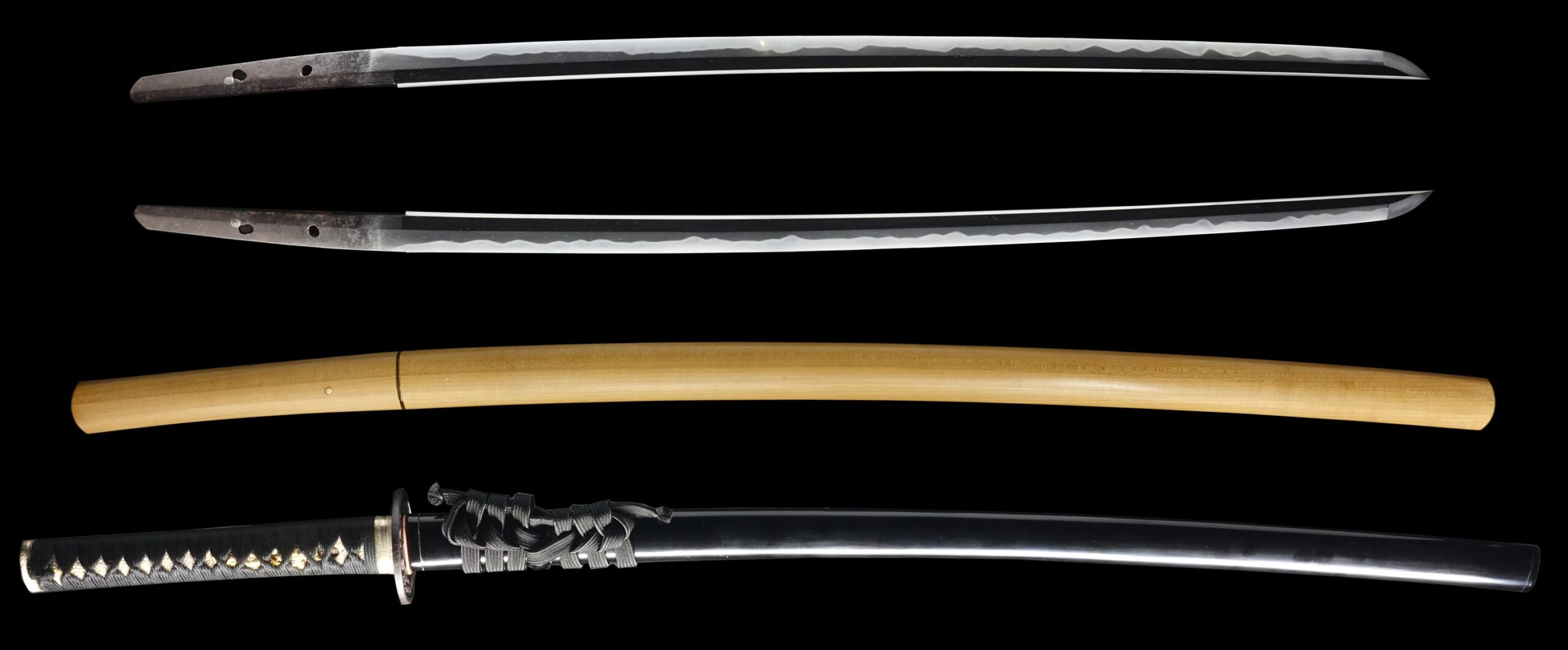
Hamon:
The crystalline structure which forms along the cutting edge of a blade as a result of the hardening process
Jimon(Jihada):
visible steel surface pattern created by folding and hammering during forging process
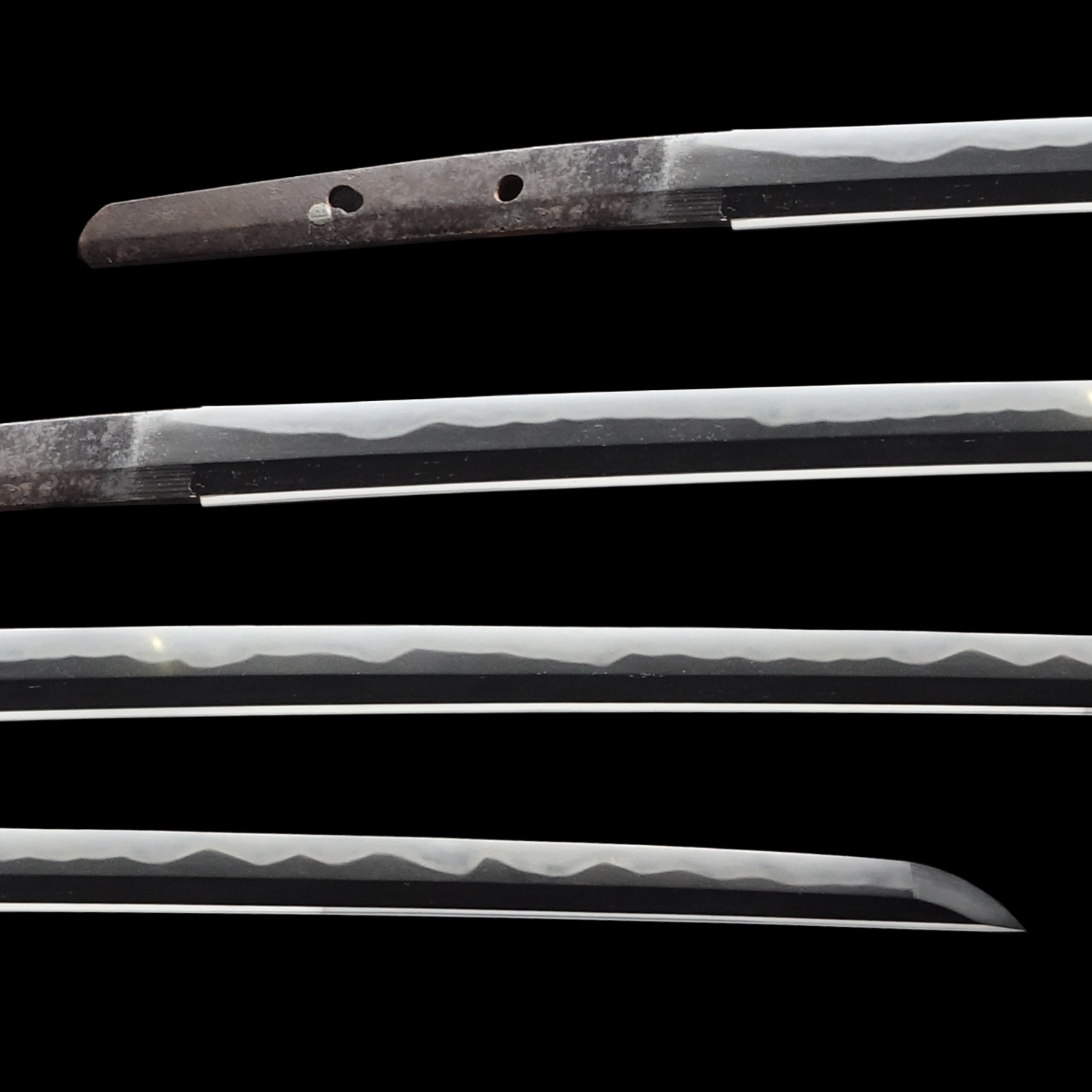
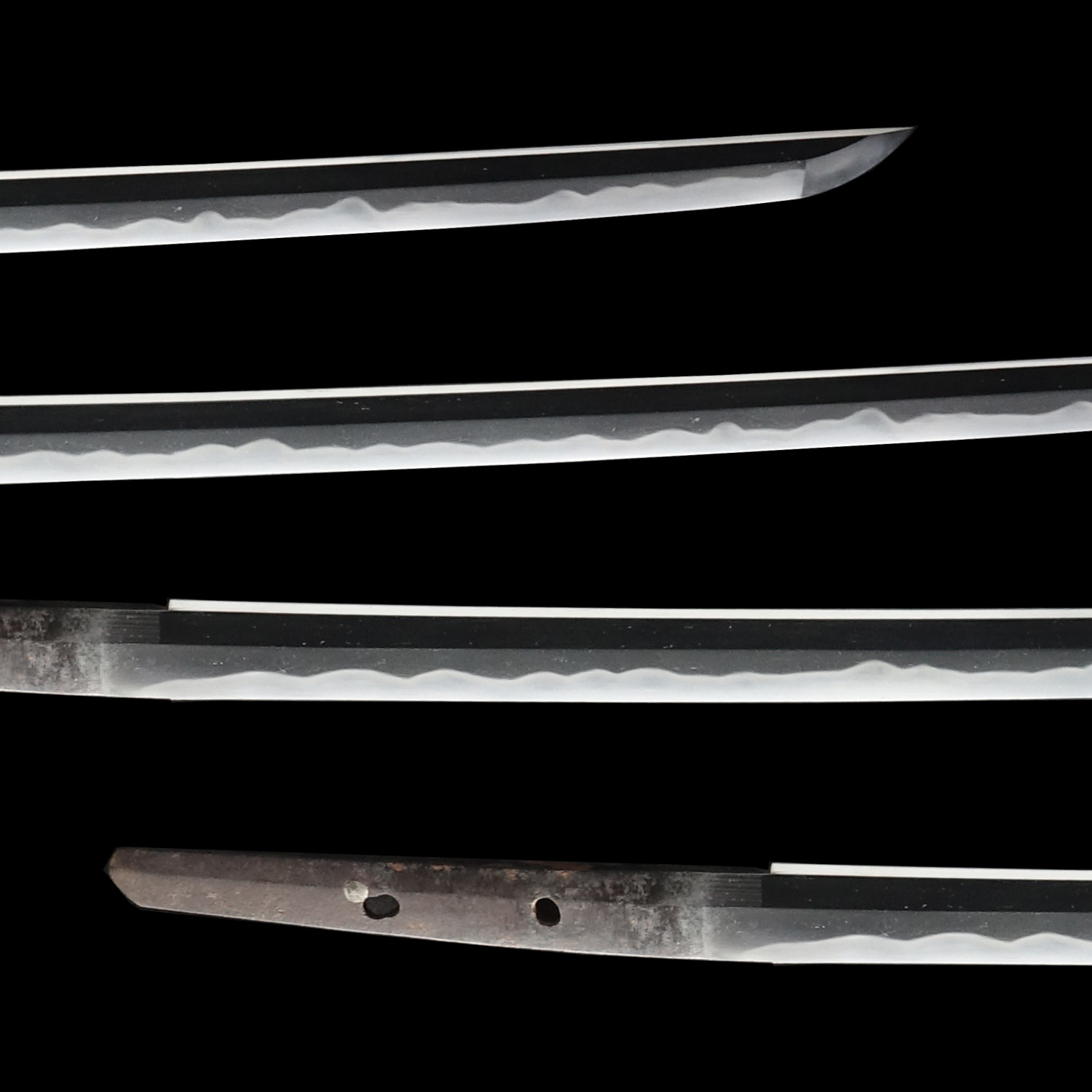
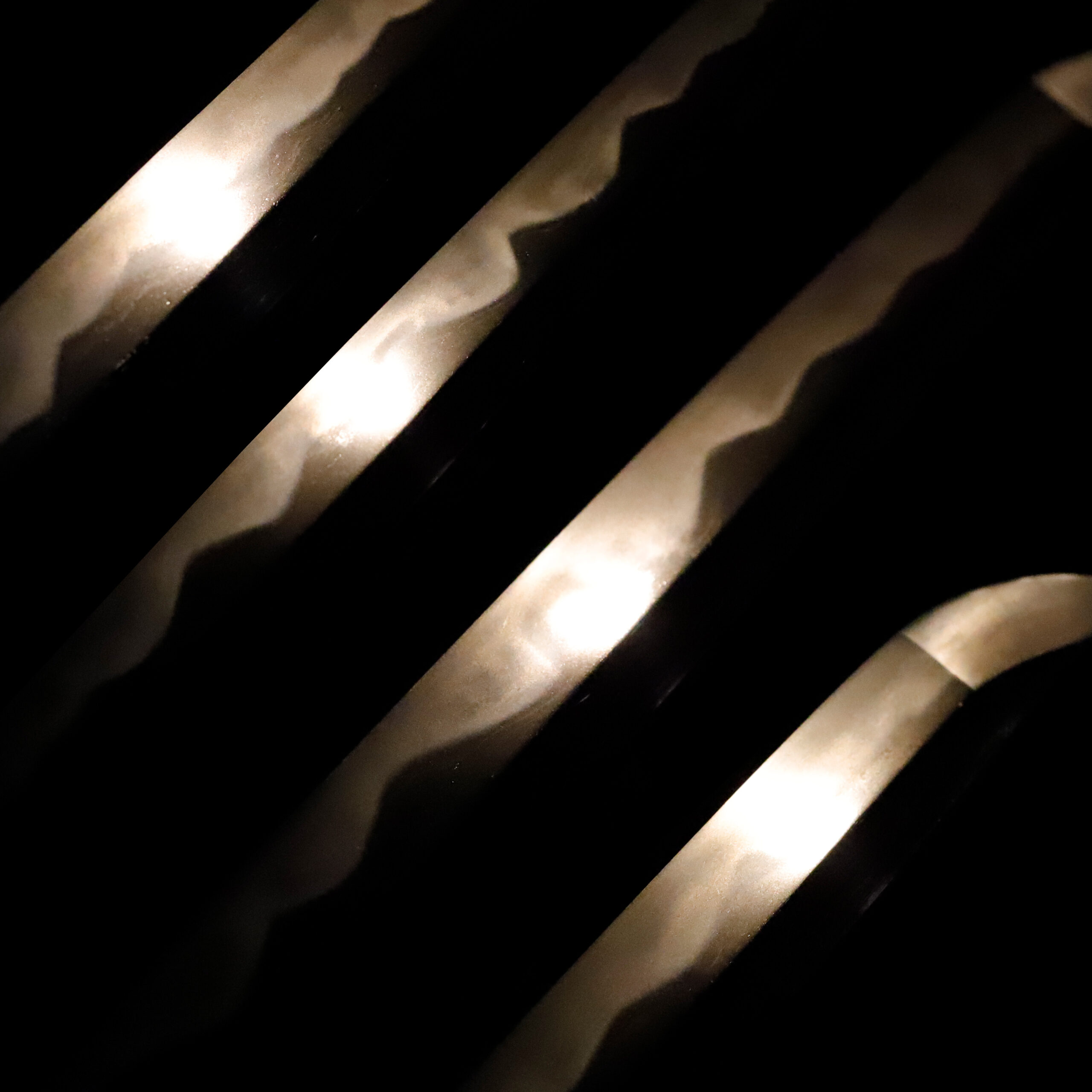
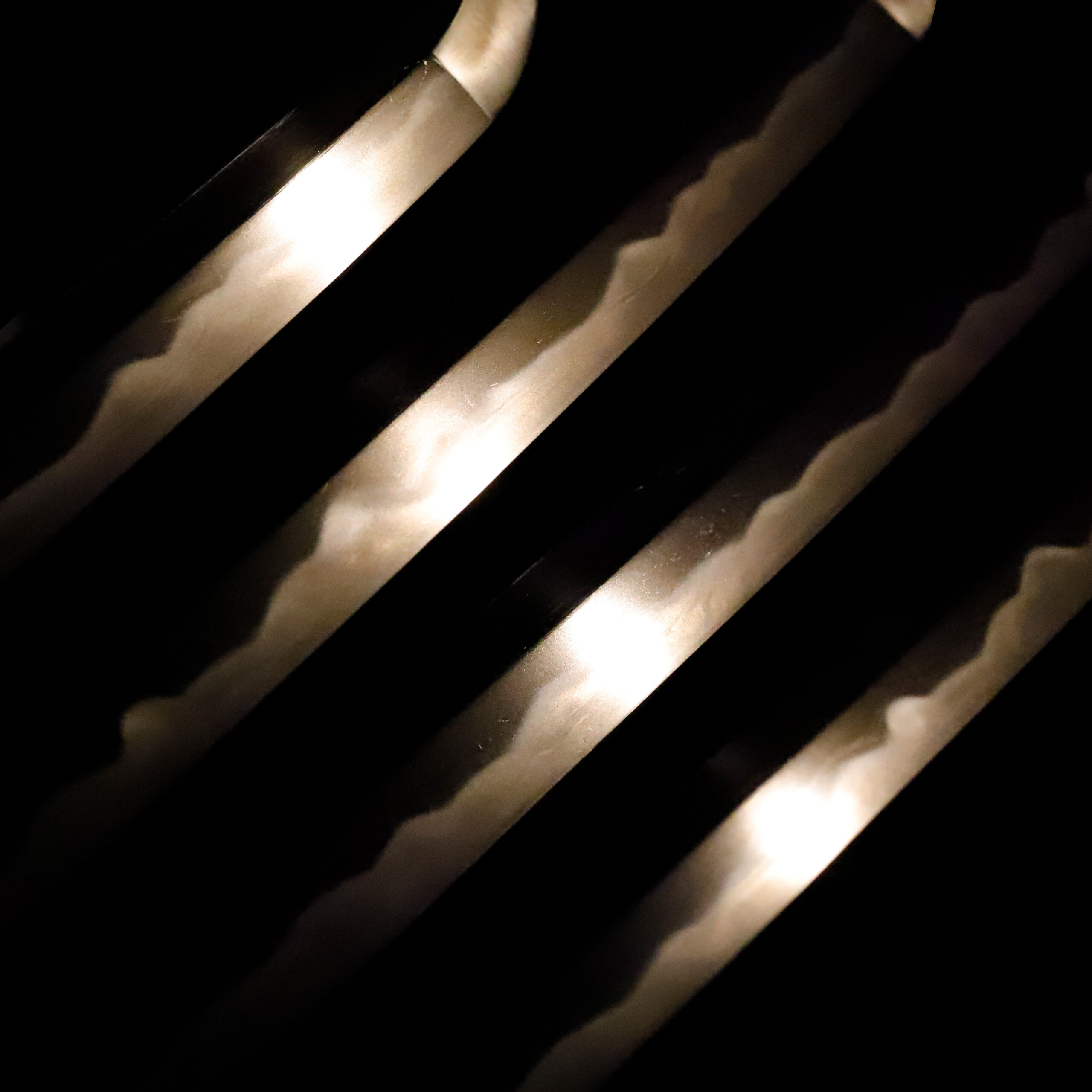
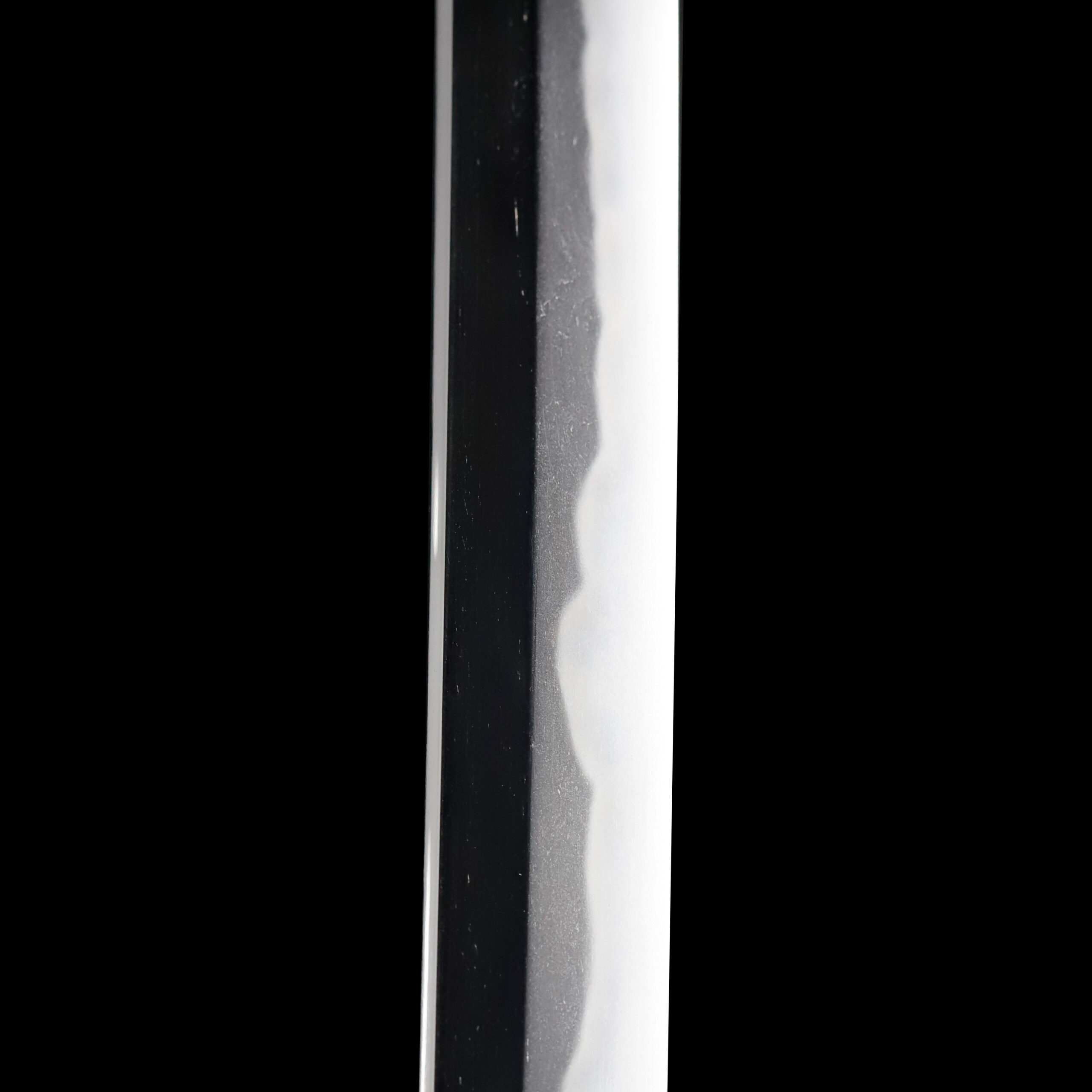

Nakago:Nakago is the tang of the Japanese sword.
Japanese swordsmiths left the black rust on the tang because it prevents red rust while the tang is in its handle. And the discoloration of the tang was created over time, and it is a great indicator for a Japanese sword specialist to estimate when the sword was forged.
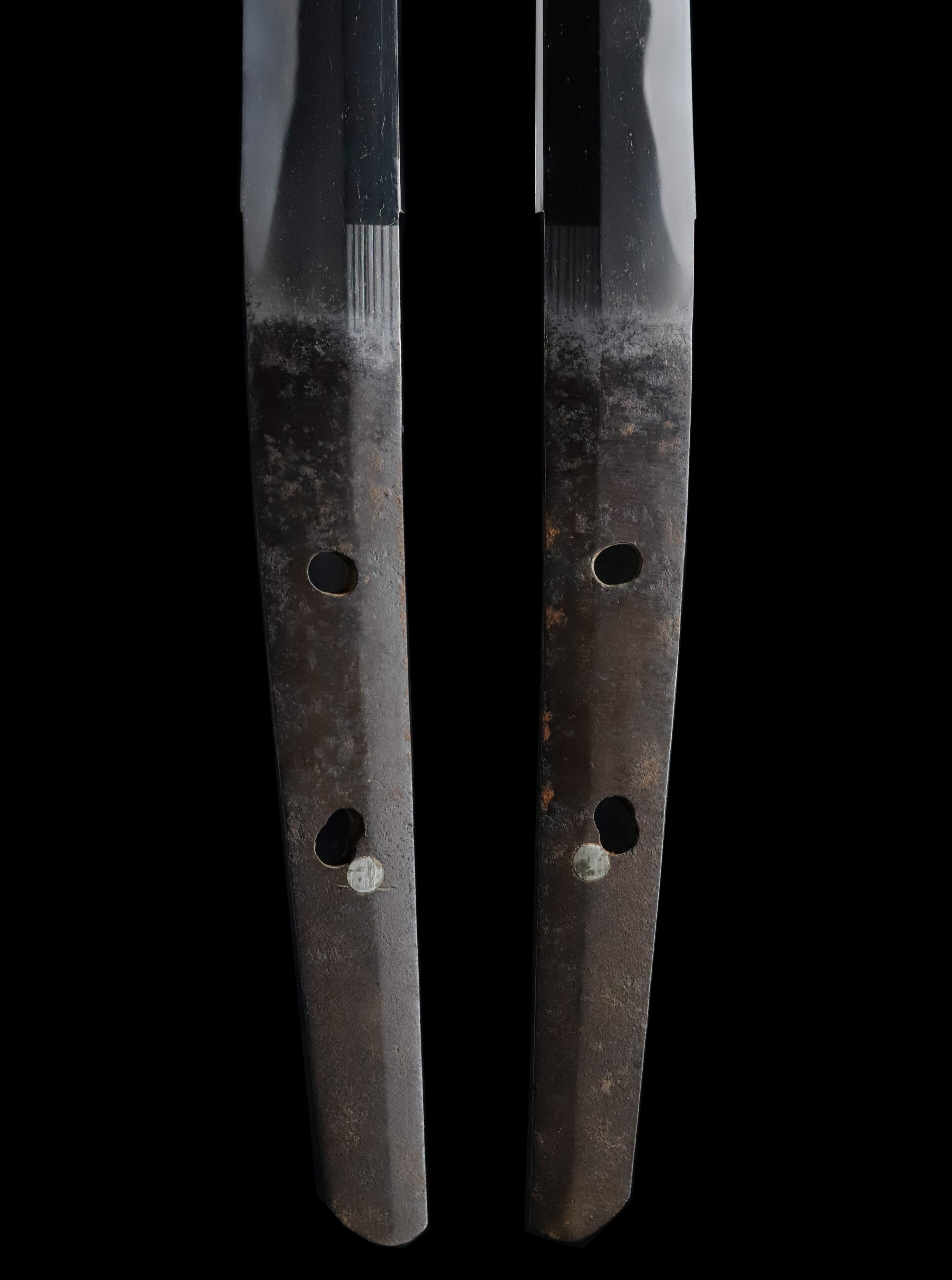
Koshirae: Koshirae is the mounting of the Japanese sword. There are several parts that consist of Koshirae such as Saya(Scabbard), Tsuka(Handle), Tsuba(Handguard).
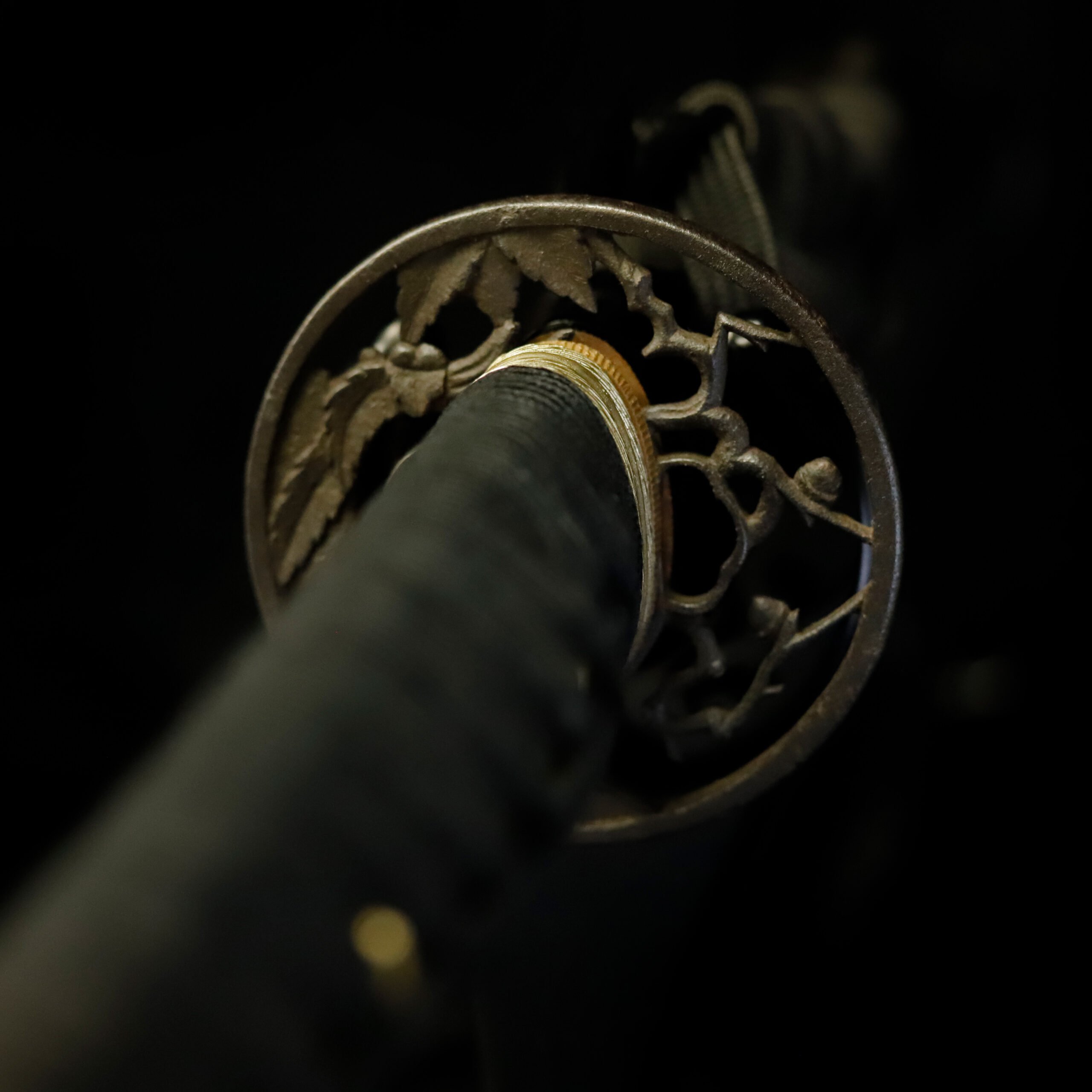
Fuchi-Kashira:A pair of matching sword fittings that cover the upper and bottom parts of its sword hilt.
This Fuchi Kashira is colored a bright color. By combining with the gold color of the Menuki (please check the description below), the overall impression of this handle is brilliant. There is a technique used to decorate metal works such as sword mountings; Shigure Yasuri (時雨鑢). It is a file that is cut diagonally and intermittently, like a drizzle in a Japanese painting. Lines are carved steeply, and these lines are likened to rain. We estimate such a decorative technique was possibly used for this Fuchi Kashira.
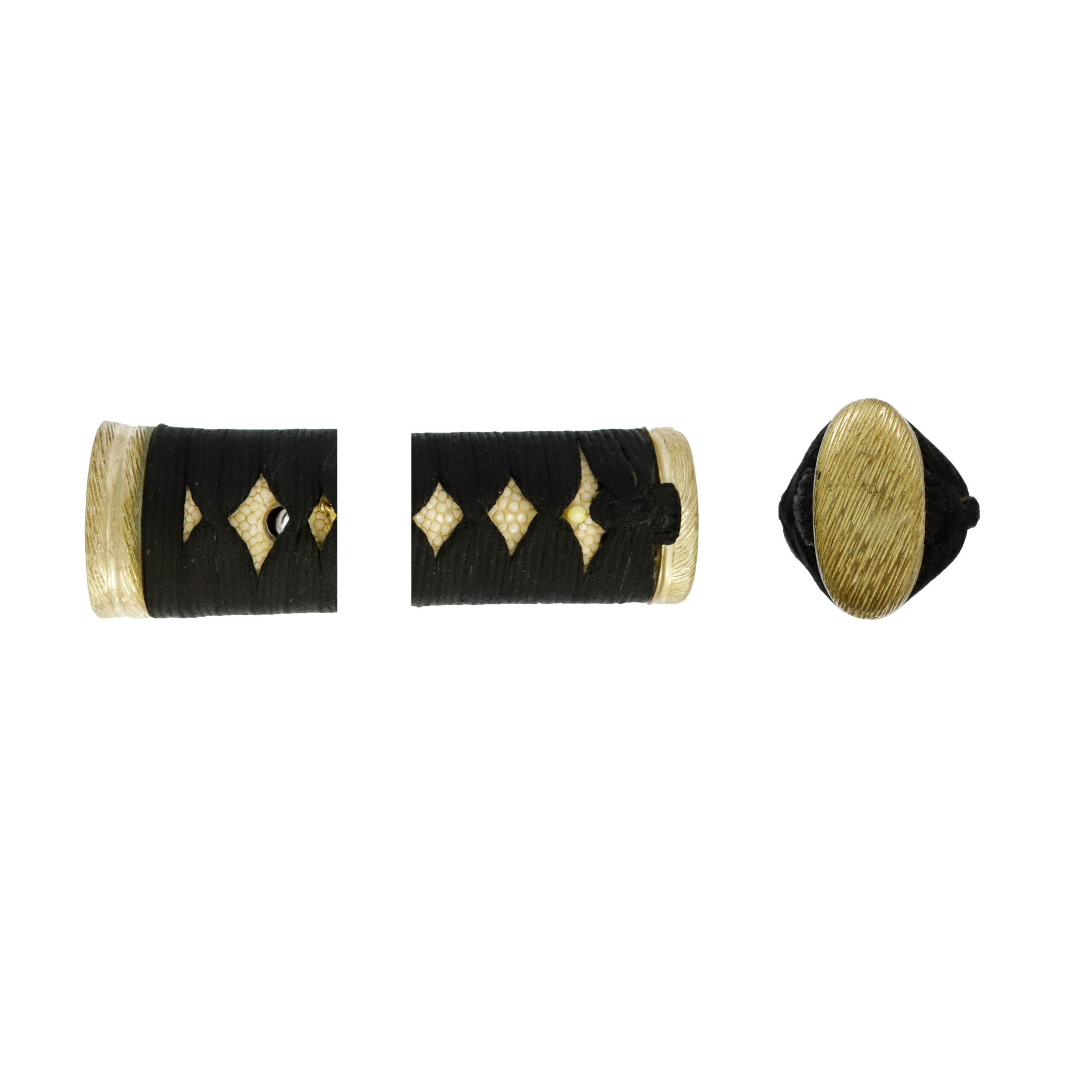
Tsuka and Menuki:Tsuka is the handle of the Japanese sword and Menuki is its decoration.
Seeing from the gaps of the Tsukamaki thread, we could find a figure of the dragon on each side of the handle. Their entire surface is covered with gold plating, and its shiny color makes this handle looks gorgeous.
Initially, the dragon was an imaginary creature found in ancient foreign traditions and myths. Furthermore, it is regarded as a symbolic beast of auspicious signs. Its body is likened to nine animals: antlers are deer, the head is a camel, eyes are demons, the neck is a snake, the belly is the Mizuchi (蛟, a mythical animal in Japan that looks like a snake and has a horn and four legs), scales are fish, claws are falcons, palms are tigers and ears are cows. The dragon was thought to reign at the top of all animals because of its odd appearance.
If you focus on the lower side handle’s Menuki, you will find that this dragon brings a ball-shaped object in its hand. It is the Nyoi Houju (如意宝珠, Cintāmaṇi), a fantasy jewel that fulfills any desire and gives out treasure, clothes, food, and drinks. Moreover, it heals illness and suffering, removes evils, purifies muddy water, and prevents disasters. It is said this magical item is taken from the brain of the dragon king.
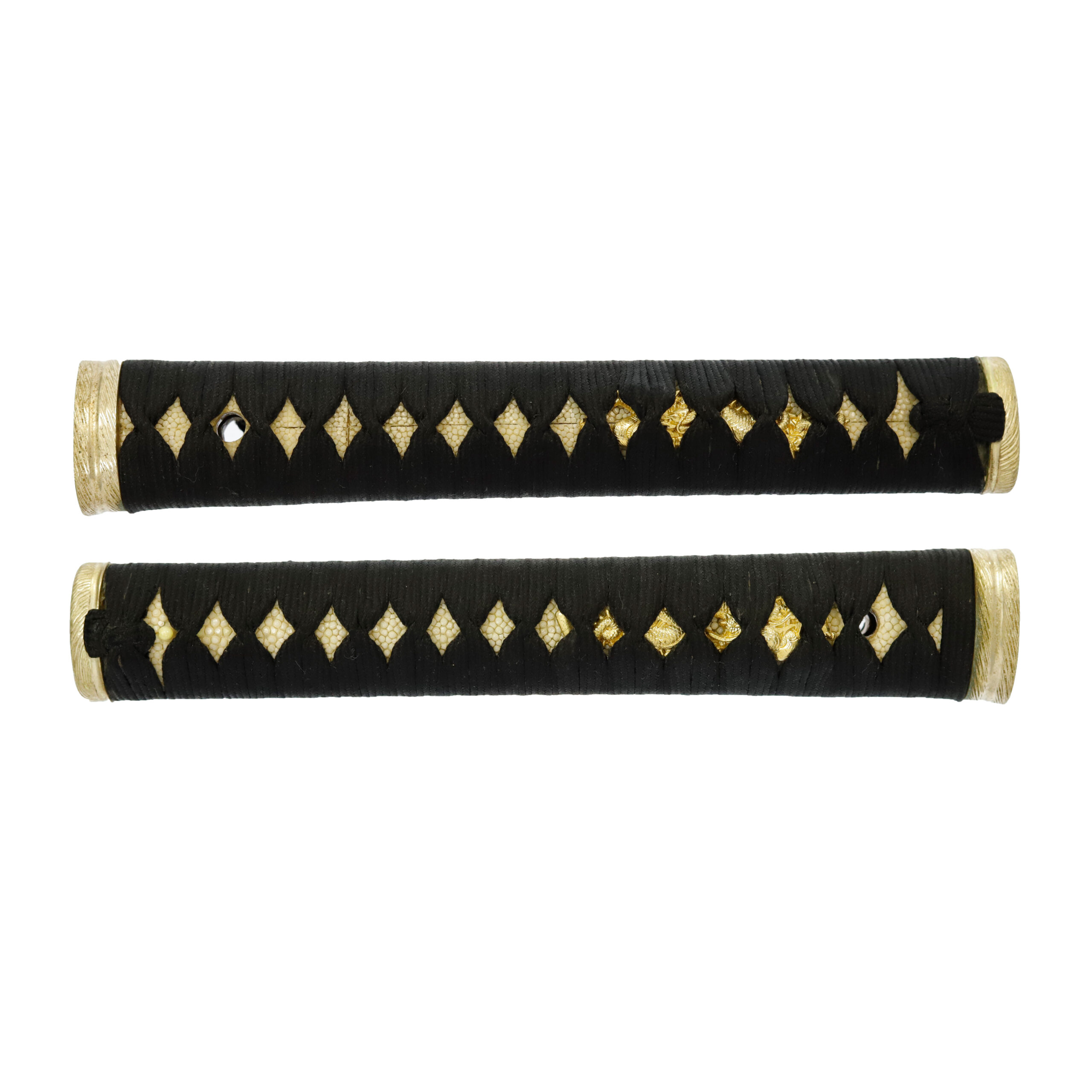
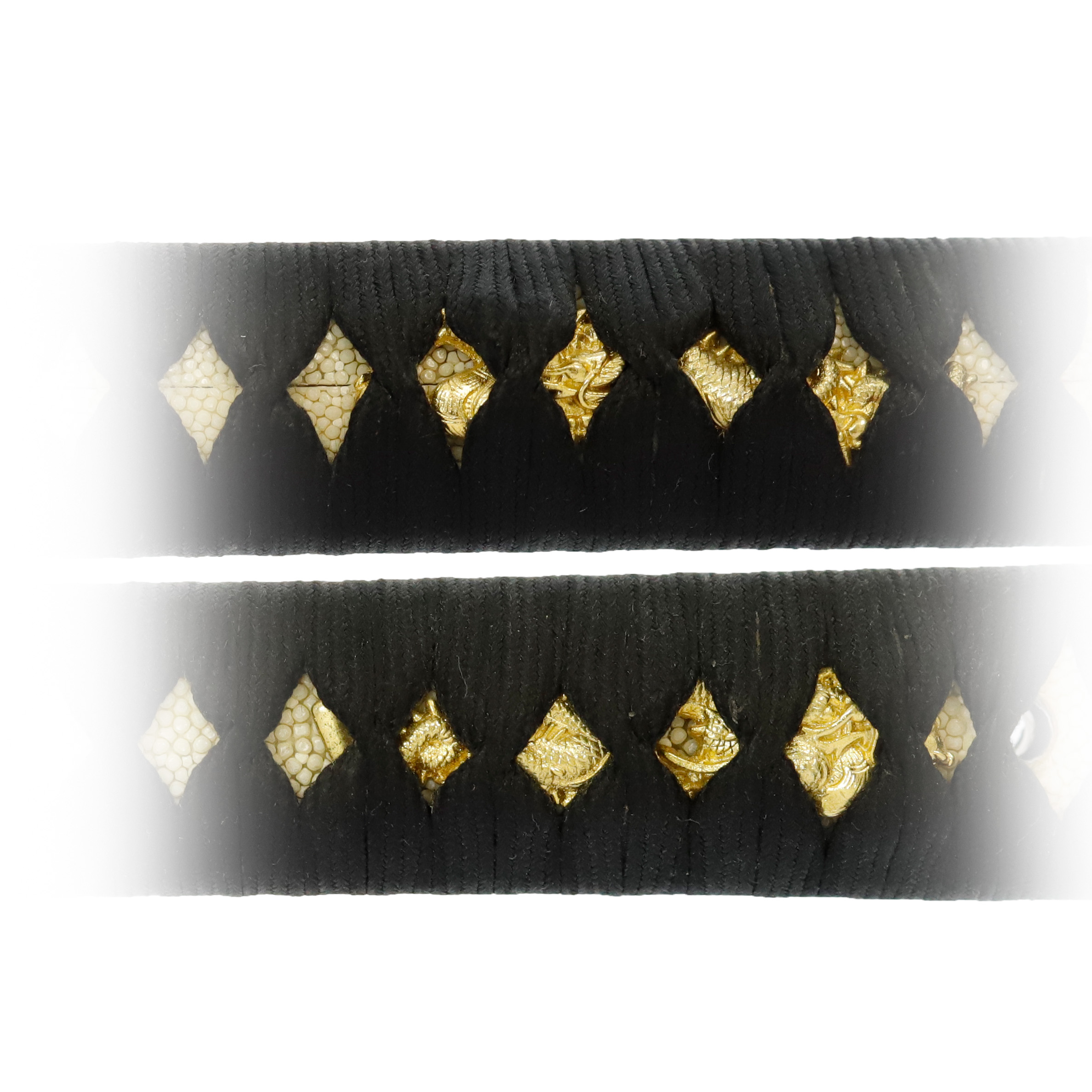
Tsuba and Habaki:Tsuba is the handguard for the Japanese Sword and Habaki is the equipment to make the blade not touch its scabbard inside. It prevents the blade from getting rusty and chipped.
This Tsuba has Kozuka and Kougai holes. About the design, its motif is the Ume (梅, Japanese apricot blossom) tree. Branches extend from a thick trunk, and these branches have several buds. The buds are round and swollen and seem to be they are about to reach the time of blooming. A single life in the natural world is vividly expressed within this circular screen.
Japanese apricot blossoms begin to bloom in winter while snow still covers its tree. Therefore, people thought this flower told the arrival of spring. Same as cherry blossom, this plant has been appreciated for a long time in Japan. People enjoy its adorable petal shape and scent and gracefully branched tree and compose many poems. As it comes out in the cold season, it symbolizes the power of perseverance and vitality.
In addition, this plant design has other auspicious meanings. As mentioned above, its Japanese name is written as follows: 梅. This character is composed of two parts; 木 and 毎. The letter 毎 is a hieroglyph that means a mother who gives birth to a child. And since its pronunciation has a sense of “birth,” Japanese apricot blossom patterns have the meaning of wishing for the prosperity of descendants. Also, this design represents happy marriage because of the looks of Umeboshi (梅干し, brined ume fruits). It is a flower pattern that Japanese people have loved for a long time because of its elegant appearance of flowers and various auspicious connotations.
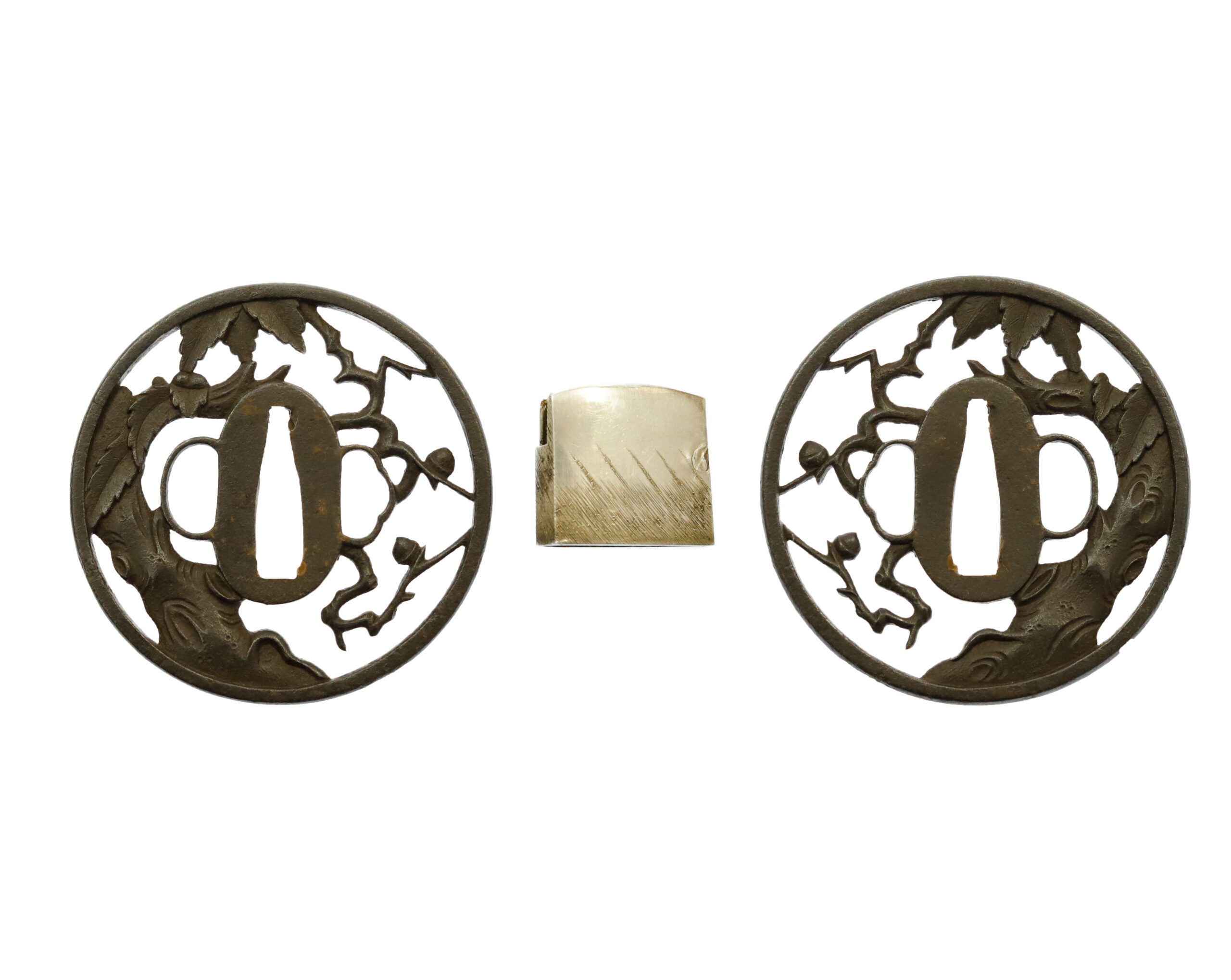
Saya: Saya is the scabbard for the Japanese sword.
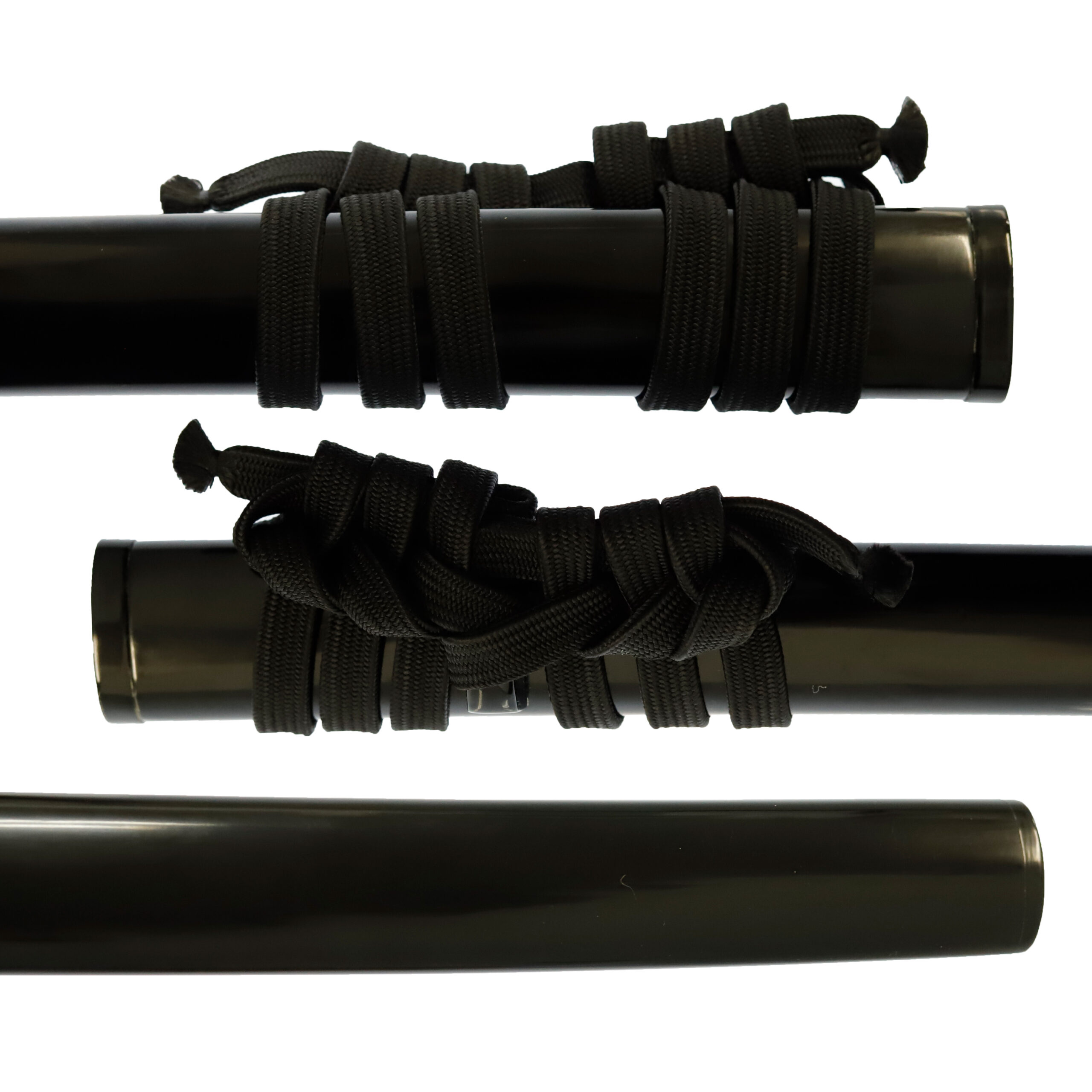
Authentication Paper:NTHK Kanteisho Certificate for the blade
NTHK, also known as NPO Nihon Touken Hozon Kai, is the oldest organization for sword authentication of Japanese swords in modern times. It was established in 1889 during the post-Samurai era. They authenticated the blade on December 15th in the 25th year of Heisei (2013). We are expecting to receive the paper by the end of March. The purchaser will receive this original certificate as well. We can also translate what is written into English and make a PDF file for your record if you request.

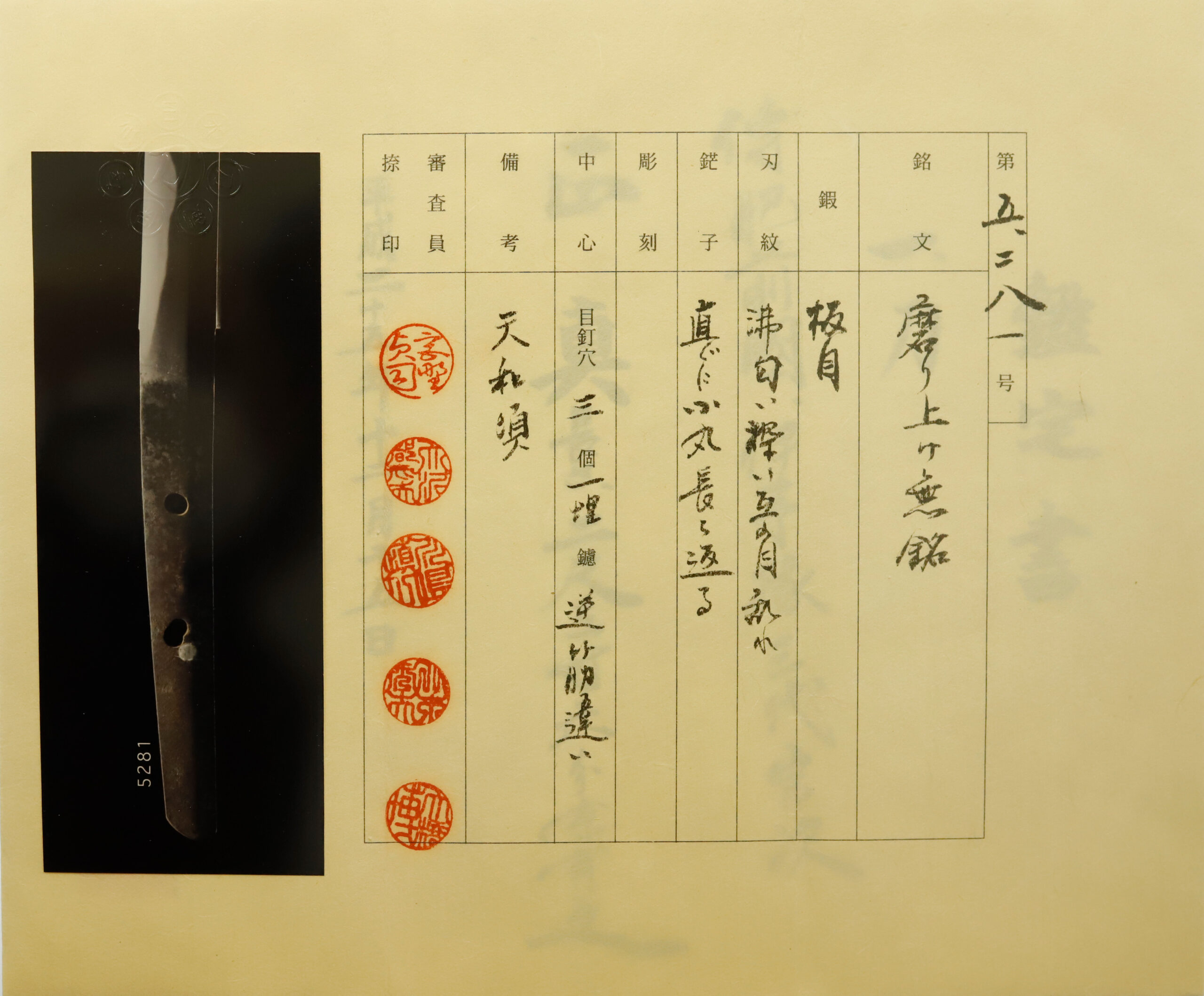
Registration Number : Tokyo 310898
The Board of Education in Tokyo prefecture issued a registration paper for this sword . It is called Jyu Token Rui Torokusho(銃刀剣類登録証). Bunkacho(The Agency for Cultural Affairs) acknowledges a Japanese sword with this paper as a work of art.
The sword needs to be traditionally hand-forged and made of Tamahagane carbon steel to be registered in the system. With this paper, its owner in Japan can legally own an authentic Japanese sword. Based on this registration number, we will apply for its export permit.
This paper will need to be returned to the board of education when the sword is being shipped abroad, but you can receive a copy of it. An English translation of this registration paper is available on request.
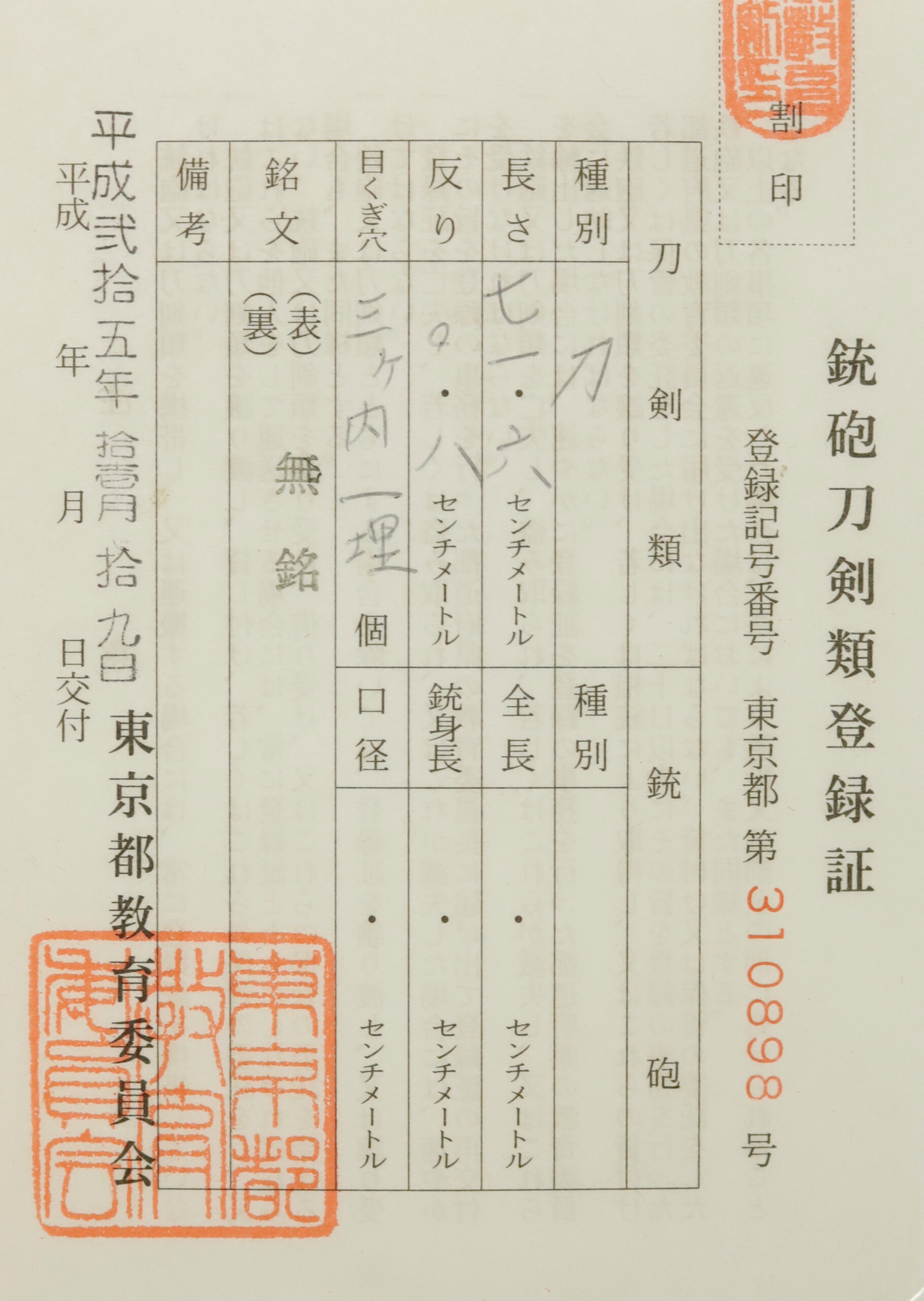
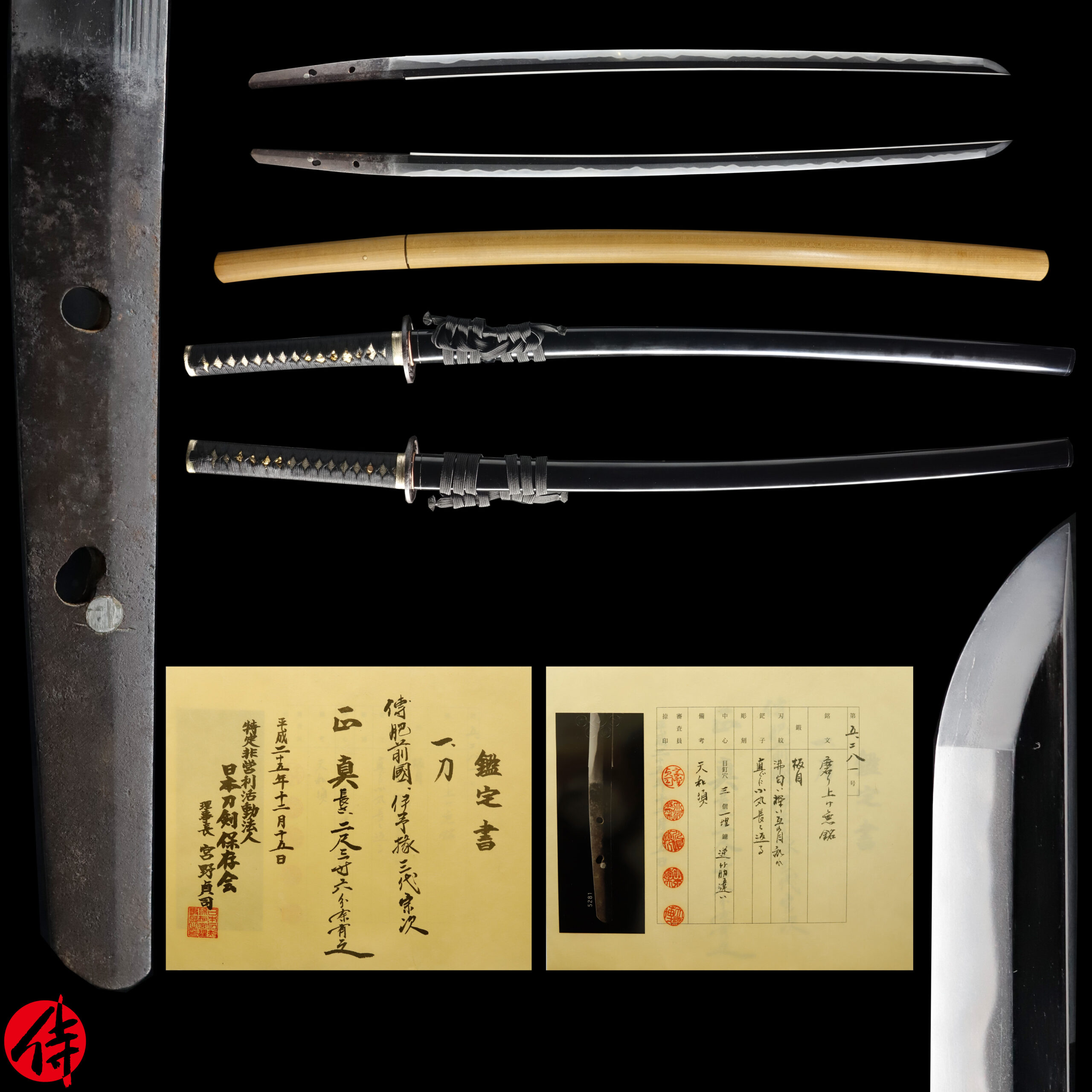
—————————————————————–
【About us】
Samurai Museum is located in Tokyo, Japan, exhibiting antique artifacts related to the Samurai history. Samurai Museum Shop is the place for those who are interested in Japanese culture and craftsmanship. We deal with antique Samurai swords/armor, traditional crafts made in Japan and so on.
【Japanese Sword& Export Process】
The Japanese swords we deal with are hand-forged edged swords made in Japan. It was made from the traditional carbon steel called TAMAHAGANE(玉鋼). Samurai Museum is familiar with the proper legal procedure for an antique/ authentic Japanese sword to be exported from Japan. We have sent more than 500 Japanese swords for the past three years (~2023) to amazing owners who appreciate its historical value.
Each Japanese sword is registered under the Agency for Cultural Affairs and the Board of Education in Japan. They issue a registration paper for each Japanese sword for its owner in Japan to legally possess it. The Japanese sword with its registration paper means it was traditionally hand-forged in Japan.
To legally export the sword from Japan to other countries, we will have to apply for its permit to the Agency for Cultural Affairs(Bunkacho) and return the original registration paper to the Board of Education. It normally takes around 2-4 weeks to receive this permit after submitting required documents. And we would like you to expect at least 1-1.5 months for your order to arrive at your given address after you ordered. For more detailed info, please click here.
It is allowed for residents in Japan to own authentic Japanese swords without a special license as long as they come with registration papers. Please feel free to contact us if you are a resident of Japan, whether temporarily or permanently. We will also assist you when you leave Japan and need to obtain the export permit.
【Payment Method】
We accept payment through Stripe (Credit card), PayPal, Apple Pay or ChromePay, all of which are secure payment methods. Also, you don’t need to make an account on Stripe for the checkout. If you prefer other payment method, please contact us. After confirming your payment, we will apply for an export permit. You may either pay in JPY, USD, AUD, CAD,EUR CHF or GBP. The price is set in Japanese Yen. Prices in other currencies are automatically calculated based on the latest exchange rate.

* If the amount is above 1 million JPY, Stripe or wire transfer will be the only options for payment.
【Shipping】
We have shipped authentic Japanese swords to the USA, UK, Canada, Mexico, Germany, France, Hong Kong and Australia. If you don’t live in these countries and like to order, please contact us first before making a purchase. We offer Free International Shipping as long as we can send antique Japanese swords by EMS.
We normally ship by EMS(Express Mail Service) provided by Japan Post. We will send you a tracking number for your order as soon as we hand it to the post office. We will put 100 % insurance on the shipping document without any extra charge. Based on the total amount, there might be a duty tax or other fee for you to pay, depending on the countries. We use package cushioning to protect the item and put it in a PVC pipe, which is one of the most secure packages because of its durability.
It will normally takes 5-14 days for the item to arrive at your given address after we dispatch it. Time of delivery is estimated as accurately as possible by the carrier but does not take into account any delays beyond our control such as by inclement weather, post office holiday seasons.
* If you live in Australia and like to purchase an authentic Japanese sword, please click here to know the detail.
*Please keep in mind that due to the spread of COVID-19, there might be delays in shipping. If you like to know the detail about shipping, please feel free to ask us.

【Review】
Here is one of the reviews we received from a customer who purchased an authentic Japanese sword from us. For more reviews, please click here.
“My experience overall with the whole process was wonderful. I had many questions about the history and process to purchase these treasures. All my questions were answered very timely and complete. The staff is very knowledgeable and very well versed if any questions do arise.”
【How to make sure the condition】
Please keep in mind that what you are going to purchase is an antique item. We uploaded high resolution photos for you to check its condition thoroughly. If you like to see more photos with different angles, please feel free to contact us. We will be happy to send them to you so that you can make informed decision. It is essential for us to know that you are happy with your choice of a sword. and we are prepared to use the best of our ability to serve you.
【How To Contact Us】
Please contact us through email, Facebook Messenger or Live Chat if you have any questions. You can find each icon on the right side of the website. Please click one of them to reach us. We will reply to you within 1-2 business days.
【The Art of Nihonto (Japanese Sword)】
Samurai’s history is a profound, eloquent legacy of ancient Japanese warriors in which millions of people worldwide are being fascinated. If you like to find out the art of Nihonto, please click here.
【A Guide to Japanese Sword Maintenance】
After acquiring an genuine Japanese sword, it is also important to know how to take good care of it. Here is the special video for you. Mr. Paul Martin, Japanese sword expert, shows you how to give proper maintenance to your sword. By mastering how to clean the Japanese sword, its aesthetic beauty will last forever.
When you purchase a Japanese sword from us, you can get a Free Japanese sword maintenance kit. It comes with four tools(Choji Oil, Uchiko Whetstone Powder, Peg remover, Oil Applicator). By watching the video instruction above , you can enjoy learning how to maintain your Japanese sword while appreciating it. If you have any difficulty assembling the sword or cleaning the blade, you can feel free to contact us.


MORE ANTIQUE JAPANESE SWORD FOR SALE
SWORDS WITHOUT CERTIFICATES FOR SALE
LEARN JAPANESE SWORD TERMINOLOGY
Thank you for reading all the information on the page. If you have any difficulty choosing the right Japanese sword for you, we will be more than happy to help you find the one that speaks to you the most. Please feel free to contact us.
